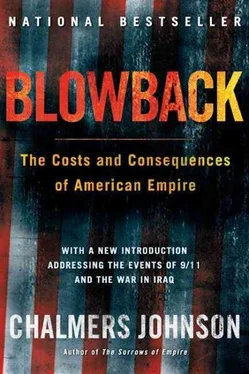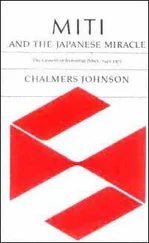Chalmers Johnson - Blowback, Second Edition - The Costs and Consequences of American Empire
Здесь есть возможность читать онлайн «Chalmers Johnson - Blowback, Second Edition - The Costs and Consequences of American Empire» весь текст электронной книги совершенно бесплатно (целиком полную версию без сокращений). В некоторых случаях можно слушать аудио, скачать через торрент в формате fb2 и присутствует краткое содержание. Год выпуска: 0101, ISBN: 0101, Издательство: Macmillan, Жанр: Старинная литература, на английском языке. Описание произведения, (предисловие) а так же отзывы посетителей доступны на портале библиотеки ЛибКат.
- Название:Blowback, Second Edition: The Costs and Consequences of American Empire
- Автор:
- Издательство:Macmillan
- Жанр:
- Год:0101
- ISBN:9780805075595
- Рейтинг книги:5 / 5. Голосов: 1
-
Избранное:Добавить в избранное
- Отзывы:
-
Ваша оценка:
- 100
- 1
- 2
- 3
- 4
- 5
Blowback, Second Edition: The Costs and Consequences of American Empire: краткое содержание, описание и аннотация
Предлагаем к чтению аннотацию, описание, краткое содержание или предисловие (зависит от того, что написал сам автор книги «Blowback, Second Edition: The Costs and Consequences of American Empire»). Если вы не нашли необходимую информацию о книге — напишите в комментариях, мы постараемся отыскать её.
Blowback, Second Edition: The Costs and Consequences of American Empire — читать онлайн бесплатно полную книгу (весь текст) целиком
Ниже представлен текст книги, разбитый по страницам. Система сохранения места последней прочитанной страницы, позволяет с удобством читать онлайн бесплатно книгу «Blowback, Second Edition: The Costs and Consequences of American Empire», без необходимости каждый раз заново искать на чём Вы остановились. Поставьте закладку, и сможете в любой момент перейти на страницу, на которой закончили чтение.
Интервал:
Закладка:
The American empire has become skilled at developing self-fulfilling—and self-serving—prophecies in order to justify its policies. It expands the NATO alliance eastward in part in order to sell arms to the former Soviet bloc countries, whose armies are being integrated into the NATO command structure, with the certain knowledge that doing so will threaten Russia and elicit a hostile Russian reaction. This Russian reaction then becomes the excuse for the expansion. Similarly, the United States sells advanced weaponry to a country without enemies, like Thailand, which in January 1997 bought $600 million worth of F-18 fighters plus the previously not-for-sale Amraam air-to-air missile. (Purchase of the aircraft was put on hold after the economic crisis erupted.) It then contends that more must be invested in arms development at home for a new generation of American fighter planes and missiles, given the necessity of keeping ahead of the rest of the world.
A classic model of the way this type of circular reasoning can lead to disaster is a U.S. decision to “help” an ally faced with domestic dissidence or even insurrection. First, the “threatened” country is declared part of America’s vital interests; next, American military personnel and commercial camp followers are sent in to “assist” the government. The foreignness of this effort as well as its indifference to democracy and local conditions only accelerate the insurrectionary movement. In the end an American protectorate is replaced by a virulently anti-American regime. This scenario played itself out in Vietnam, Cambodia, and Iran in our time. Now it appears it might do so in Saudi Arabia.
Since the Gulf War the United States has maintained around thirty-five thousand troops in Saudi Arabia. Devoutly Muslim citizens of that kingdom see their presence as a humiliation to the country and an affront to their religion. Dissident Saudis have launched attacks against Americans and against the Saudi regime itself. After the June 1996 bombing of the Khobar Towers apartments near Dhahran killed nineteen American airmen, the international relations commentator William Pfaff offered the reasonable prediction, “Within 15 years at most, if present American and Saudi Arabian policies are pursued, the Saudi monarchy will be overturned and a radical and anti-American government will take power in Riyadh.” 36Yet American foreign policy remains on autopilot, instead of withdrawing from a place where a U.S. presence is only making a dangerous situation worse.
Ten years after the end of the Cold War, the Pentagon monopolizes the formulation and conduct of American foreign policy. Increasingly, the United States has only one, commonly inappropriate means of achieving its external objectives—military force. It no longer has a full repertoire of skills, including a seasoned, culturally and linguistically expert diplomatic corps; truly viable international institutions that the American public supports both politically and financially and that can give legitimacy to American efforts abroad; economic policies that effectively leverage the tremendous power of the American market into desired foreign responses; or even an ability to express American values without being charged, accurately, with hopeless hypocrisy. The use of cruise missiles and B-2 bombers to achieve humanitarian objectives is a sign of how unbalanced our foreign policy apparatus has become. The American-inspired and -led NATO intervention in Yugoslavia in the spring of 1999 to protect the Albanian majority in Kosovo was a tragic example of what is wrong.
It may or may not be prudent policy to put humanitarian objectives above respect for the sovereignty of nations; it is, in any case, a precedent-setting position that could come back to haunt the United States, which is, like Yugoslavia, a multiethnic country. But betraying no doubts whatsoever, the U.S. government disdained to seek U.N. Security Council sanction for its objectives and then chose to commit a defensive military alliance, NATO, to a totally unprecedented offensive role, in violation of the treaty that created it. Its rationale was that its end—humanitarian relief of defenseless civilians under attack by a political leader with an odious record of similar attacks in the past—justified its means: targeting high-flying bombers and cruise missiles on undefended civilian buildings (including the embassy of China) and public infrastructure, such as roads and bridges. It is not surprising that not a single American serviceman was killed. It is also not surprising that the policy produced precisely the humanitarian disaster for the Albanians in Kosovo that its ostensible purpose was to prevent. As former president Jimmy Carter put it, “Even for the world’s only superpower, the ends don’t always justify the means.” 37The United States’s objectives in Kosovo, which were arguably justifiable on their own terms, were compromised by reliance on a technologically phenomenal but utterly inappropriate military machine because it was the only means still available.
Military might does not equate with “leadership of the free world.” It is also no substitute for an informed public that understands and has approved the policies being carried out in its name. An excessive reliance on a militarized foreign policy and an indifference to the distinction between national interests and national values in deciding where the United States should intervene abroad have actually made the country less secure in ways that will become only more apparent in the years to come.
What would make the United States more secure is not more money spent on JCET teams or espionage satellites to find and retaliate against terrorists. Instead, the United States should bring most of its overseas land-based forces home and reorient its foreign policy to stress leadership through example and diplomacy. Nowhere is this more true than on the Korean peninsula. American military intervention in Korea dates back to 1945. Most of our commitments in Korea were made before current government leaders were even born. The passage of time, economic development, and the collapse of communism have rendered most of them utterly anachronistic. Yet they remain unchanged, constituting one of our greatest breeding grounds for blowback.
SOUTH KOREA:
LEGACY OF THE COLD WAR
There were many differences between the Soviet Union’s satellites in Eastern Europe and the United States’ satellites in East Asia, most importantly in the area of economic organization. In Europe, Stalin imposed on all seven of his “people’s democracies” (Albania, Bulgaria, Czechoslovakia, the German Democratic Republic, Hungary, Poland, and Romania but not Yugoslavia, which was not created by the Red Army) a uniform pattern involving the collectivization of agriculture and an extreme centralization of economic decision making. The USSR demanded that all of these countries industrialize at the fastest possible pace, with absolute priority given to heavy industry. In the period from 1947 to 1952, the Soviet Union imposed its own economic methods uncritically and without taking any cultural or other differences into account. It was a process in some ways similar to the one the International Monetary Fund imposed on the smaller, more open economies of East Asia during and after the financial crisis of 1997—and with similar results.
In contrast with the Soviet Union, the United States was much less doctrinaire about economic arrangements in its satellites during the Cold War. In Japan and South Korea, its two main dependencies in East Asia, it insisted on the institution of private property and opposed any steps toward the nationalization of industry, but it tolerated land reform, state guidance of the economy, protectionism, mercantilism, and the cartelization of industry as long as these methods produced economic growth and blunted the appeal of communism. The United States used aid and preferred access to its vast market to bring these countries into its political orbit and keep them there. It disguised what it was doing—ultimately fooling only its own people—with euphemisms like “exportled growth” and “the separation of politics and economics.” The result was that over the years places like South Korea were able to export their way to personal incomes averaging over $10,000 per capita, a process that the Western business press invariably characterized as “miraculous.” It was not a process made available to the Latin American dependencies of the United States, because they were not of equal strategic importance in the Cold War.
Читать дальшеИнтервал:
Закладка:
Похожие книги на «Blowback, Second Edition: The Costs and Consequences of American Empire»
Представляем Вашему вниманию похожие книги на «Blowback, Second Edition: The Costs and Consequences of American Empire» списком для выбора. Мы отобрали схожую по названию и смыслу литературу в надежде предоставить читателям больше вариантов отыскать новые, интересные, ещё непрочитанные произведения.
Обсуждение, отзывы о книге «Blowback, Second Edition: The Costs and Consequences of American Empire» и просто собственные мнения читателей. Оставьте ваши комментарии, напишите, что Вы думаете о произведении, его смысле или главных героях. Укажите что конкретно понравилось, а что нет, и почему Вы так считаете.










